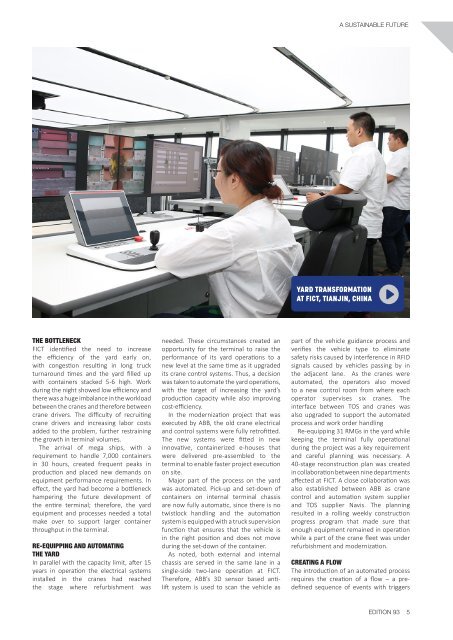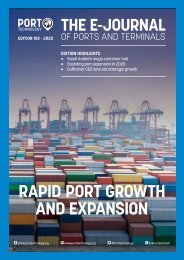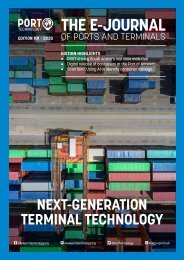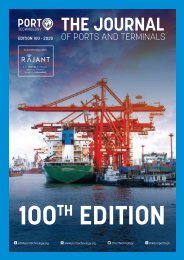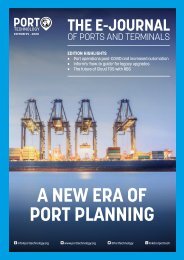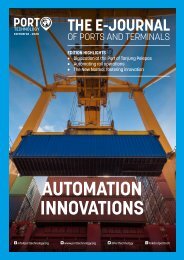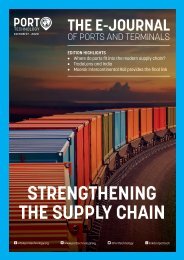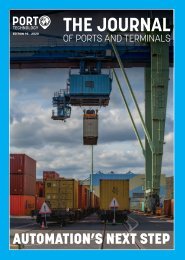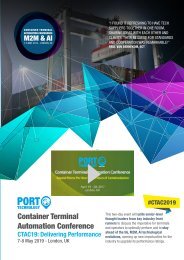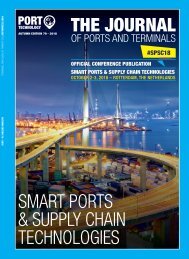A Sustainable Future
Port Technology International’s first e-Journal of 2020 explores the topic of sustainability in ports. Climate change is set to be a defining topic for the 2020s as awareness of its real-time impact is increasing.
Port Technology International’s first e-Journal of 2020 explores the topic of sustainability in ports. Climate change is set to be a defining topic for the 2020s as awareness of its real-time impact is increasing.
You also want an ePaper? Increase the reach of your titles
YUMPU automatically turns print PDFs into web optimized ePapers that Google loves.
A SUSTAINABLE FUTURE<br />
YARD TRANSFORMATION<br />
AT FICT, TIANJIN, CHINA<br />
THE BOTTLENECK<br />
FICT identified the need to increase<br />
the efficiency of the yard early on,<br />
with congestion resulting in long truck<br />
turnaround times and the yard filled up<br />
with containers stacked 5-6 high. Work<br />
during the night showed low efficiency and<br />
there was a huge imbalance in the workload<br />
between the cranes and therefore between<br />
crane drivers. The difficulty of recruiting<br />
crane drivers and increasing labor costs<br />
added to the problem, further restraining<br />
the growth in terminal volumes.<br />
The arrival of mega ships, with a<br />
requirement to handle 7,000 containers<br />
in 30 hours, created frequent peaks in<br />
production and placed new demands on<br />
equipment performance requirements. In<br />
effect, the yard had become a bottleneck<br />
hampering the future development of<br />
the entire terminal; therefore, the yard<br />
equipment and processes needed a total<br />
make over to support larger container<br />
throughput in the terminal.<br />
RE-EQUIPPING AND AUTOMATING<br />
THE YARD<br />
In parallel with the capacity limit, aer 15<br />
years in operation the electrical systems<br />
installed in the cranes had reached<br />
the stage where refurbishment was<br />
needed. These circumstances created an<br />
opportunity for the terminal to raise the<br />
performance of its yard operations to a<br />
new level at the same time as it upgraded<br />
its crane control systems. Thus, a decision<br />
was taken to automate the yard operations,<br />
with the target of increasing the yard’s<br />
production capacity while also improving<br />
cost-efficiency.<br />
In the modernization project that was<br />
executed by ABB, the old crane electrical<br />
and control systems were fully retrofitted.<br />
The new systems were fitted in new<br />
innovative, containerized e-houses that<br />
were delivered pre-assembled to the<br />
terminal to enable faster project execution<br />
on site.<br />
Major part of the process on the yard<br />
was automated. Pick-up and set-down of<br />
containers on internal terminal chassis<br />
are now fully automatic, since there is no<br />
twistlock handling and the automation<br />
system is equipped with a truck supervision<br />
function that ensures that the vehicle is<br />
in the right position and does not move<br />
during the set-down of the container.<br />
As noted, both external and internal<br />
chassis are served in the same lane in a<br />
single-side two-lane operation at FICT.<br />
Therefore, ABB’s 3D sensor based antili<br />
system is used to scan the vehicle as<br />
part of the vehicle guidance process and<br />
verifies the vehicle type to eliminate<br />
safety risks caused by interference in RFID<br />
signals caused by vehicles passing by in<br />
the adjacent lane. As the cranes were<br />
automated, the operators also moved<br />
to a new control room from where each<br />
operator supervises six cranes. The<br />
interface between TOS and cranes was<br />
also upgraded to support the automated<br />
process and work order handling<br />
Re-equipping 31 RMGs in the yard while<br />
keeping the terminal fully operational<br />
during the project was a key requirement<br />
and careful planning was necessary. A<br />
40-stage reconstruction plan was created<br />
in collaboration between nine departments<br />
affected at FICT. A close collaboration was<br />
also established between ABB as crane<br />
control and automation system supplier<br />
and TOS supplier Navis. The planning<br />
resulted in a rolling weekly construction<br />
progress program that made sure that<br />
enough equipment remained in operation<br />
while a part of the crane eet was under<br />
refurbishment and modernization.<br />
CREATING A FLOW<br />
The introduction of an automated process<br />
requires the creation of a ow a predefined<br />
sequence of events with triggers<br />
EDITION 93 5


